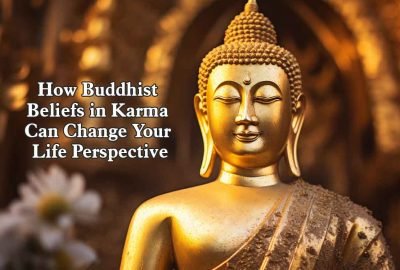Buddhism
Buddhism is a spiritual belief system that originated in India. It focuses on understanding and overcoming suffering through teachings like the Four Noble Truths and the Eightfold Path. It emphasizes meditation, ethical behaviour, and mindfulness to attain refinement. Buddhism promotes compassion and seeks to break free from attachment and craving. It has various branches and is practised by millions globally.
Introduction to Buddhism
Buddhism, a profound and ancient spiritual tradition, traces its origins back 2,500 years to India. With millions of followers worldwide, it has become one of the globe’s prominent religions. At its core is the recognition that human existence involves suffering. To attain enlightenment or nirvana, Buddhists dedicate themselves to practices like meditation, ethical living, and self-improvement. The Four Noble Truths and the Eightfold Path outline the framework for comprehending suffering’s nature, its causes, and the journey to liberation.
The Four Noble Truths serve as the foundational principles of Buddhism. These truths acknowledge the reality of suffering (dukkha) as an intrinsic part of human life. They identify the causes of suffering, which stem from attachment, craving, and ignorance. The Four Noble Truths also reveal that liberation from suffering is attainable, and they provide a path to its cessation.
The Eightfold Path, a comprehensive guide to ethical and mental development, outlines the means to overcome suffering. This path is divided into three categories: Wisdom (Right Understanding and Right Intention), Ethical Conduct (Right Speech, Right Action, and Right Livelihood), and Mental Discipline (Right Effort, Right Mindfulness, and Right Concentration). By cultivating these qualities, individuals gradually transform their understanding, behaviour, and mindset, leading to liberation.
Buddhism does not rely on deities or gods for salvation. Instead, it highlights personal effort and self-awareness. Meditation, a cornerstone of Buddhist practice, aids in developing mindfulness and concentration, enabling practitioners to gain insight into the nature of reality and the impermanence of all things.
The ultimate goal in Buddhism is to reach nirvana, a state of perfect peace, enlightenment, and liberation from the cycle of birth, death, and rebirth (samsara). Achieving nirvana involves transcending the ego, desires, and suffering, leading to a state of profound contentment and freedom.
Buddhism has diversified into various schools and traditions over time, including Theravada, Mahayana, and Vajrayana. These branches offer different approaches to practice, philosophy, and rituals, catering to the diverse spiritual needs of followers.

Buddha and Mind
In Buddhist philosophy, the mind holds a central place, serving as a foundation for understanding human experience and the path to enlightenment. Just as a calm lake reflects the clarity of the sky, the mind, when cultivated, can reflect the truth of existence. The Buddha’s teachings highlight the power of the mind in shaping our perceptions, emotions, and actions. By taming the mind through mindfulness, meditation, and self-awareness, we can unravel the complexities of existence and find lasting peace within ourselves.
The Four Noble Truths of Buddhism
The Four Noble Truths are the main principles in Buddhism that outline the nature of suffering and the path to freedom. They were told by Siddhartha Gautama, the Buddha, as the core framework for learning and addressing suffering in human life.
Here are the Four Noble Truths:

The Truth of Suffering - Dukkha
The first noble truth acknowledges the presence of suffering, dissatisfaction, and discomfort in human life. This suffering can manifest in various forms, both physical and mental.
It highlights the impermanence and uncertainty that characterise existence.

The Truth of the Origin of Suffering - Samudaya

The Truth of the Cessation of Suffering - Nirodha


The Truth of the Path to the Cessation of Suffering - Magga

The Four Noble Truths of Buddhism give an in-depth framework for comprehending the nature of suffering, its causes, and how to overcome it. They lay the basis for Buddhist thought and practice, directing people towards a life of mindfulness, ethical behaviour, and spiritual development.
7 Levels of Meditation
The seven levels of meditation represent stages of deepening awareness and inner peace. As we progress, we move from a wandering mind to tranquil focus, experiencing moments of joy, profound calmness, and finally, an equilibrium of the mind. Each level brings us closer to a state of balanced serenity, guiding us on a transformative journey towards self-discovery and harmony.
Mind-wandering (Kamacchanda)
The mind tends to wander and is easily distracted.
Dullness and drowsiness (Thina-middha
A sense of mental fogginess or lethargy prevails.
Restlessness and remorse (Uddhacca-kukkucca)
The mind feels agitated or troubled.
Joy (Piti)
A feeling of happiness and contentment arises
Peace (Passaddhi)
A deep calm and serenity settle in
Concentration (Samadhi)
The mind achieves focused, one-pointed attention.
Equanimity (Upekkha)
A state of balance and equanimity is attained
Buddhism For Beginners
Are you pursuing inner peace, mindfulness & a deeper connection with the world around you? With its profound teachings and practical approach, Buddhism could be the path you’re looking for. Read the following steps its help you begin your journey into Buddhist practice.
Top 8 Steps For Beginner Buddhists
Mindfulness is at the core of Buddhist practice. Begin by finding a quiet space where you can sit comfortably. Close your eyes and focus on your breath. Let go of distractions and simply observe your inhalations and exhalations. If your mind wanders, gently guide your attention back to your breath. Start with just a few minutes each day and gradually extend your practice.
Understanding the Four Noble Truths is key to grasping the essence of Buddhism. These truths revolve around the reality of suffering (dukkha), its origin (samudaya), its cessation (nirodha), and the path to cessation (magga). Reflect on how these truths relate to your own experiences and challenges.
The Eightfold Path provides a roadmap for ethical and mental development. It encompasses the proper understanding, intention, speech, action, livelihood, effort, mindfulness, and concentration. Study each aspect and contemplate how you can integrate them into your life.
Loving-kindness (Metta) meditation is a powerful practice that nurtures compassion. Begin by sending positive thoughts and well-wishes to yourself. Gradually extend these sentiments to loved ones, acquaintances, and even those you may have conflicts with. This practice expands your capacity for empathy and understanding.
Buddhist practice isn’t confined to meditation. Embrace mindfulness in your daily activities. Whether you’re eating, walking, or working, focus your attention on the task at hand. This simple shift in awareness can bring a sense of presence and fulfilment to every moment.
Dive into books and online resources to learn about Buddhist philosophy, history, and teachings. Reading the works of renowned Buddhist teachers can provide insights and guidance that deepen your practice.
Connecting with like-minded individuals can be incredibly enriching. Seek out local Buddhist meditation groups, temples, or online communities. Engaging with others can offer support, opportunities for discussion, and a sense of belonging.
Be patient, forgiving, & understanding toward yourself as you explore and learn.
Buddhism for beginners, the path of Buddhism is unique for everyone. Adapt these practices to fit your own life possibilities and preferences. As you continue to explore and integrate these principles, you’ll find that the wisdom of Buddhism can profoundly transform your attitude and lead to a more meaningful and fulfilling life.
Buddhist Meditation
Buddhist meditation is a practice that can help you relax your mind, expand your awareness, and find inner peace. It involves relaxing silently and concentrating on your breath, thoughts, and sensations. Practising this will teach you to examine your mind without becoming distracted by thoughts or feelings. This practice assists you in becoming more present and less stressed, resulting in a deeper understanding of yourself and the world around you.
What is Meditation?
Meditation is a practice that trains the mind to be fully present with relaxation, heightened awareness, and inner peace. It provides a space to quiet the mind’s chatter, bringing about a sense of clarity and stillness.
What is the first rule in meditation?
The first rule in meditation is setting a clear intention. Prior to beginning your meditation session, establish an intention that guides your practice. This intention becomes your compass for focused meditation.
What is the golden rule of meditation?
The golden rule of meditation is non-attachment. As you meditate, practice observing thoughts, emotions, and sensations without getting attached to them. This practice fosters detachment and a non-reactive mindset.
Buddhist Way of Meditation
What is the Buddhist Way of Meditation?
4 Stages of Buddhist Meditation
What are the 4 stages of Buddhist meditation?
Mindfulness of Body (Kayagatasati) – Directing attention to bodily sensations, breath, and posture, fostering mindfulness and detachment from the physical self.
Mindfulness of Feelings (Vedananupassana) – Exploring the arising and passing of feelings, whether pleasant, unpleasant, or neutral, without clinging or aversion.
Mindfulness of Mind (Cittanupassana) – Delving into the mind’s states, thoughts, emotions, and mental qualities to gain insight into their transient and interconnected nature.
Mindfulness of Dhammas (Dhammanupassana) – Investigating mental constructs, perceptions, and factors that shape our experience of reality.


7 Levels of Meditation
The seven levels of meditation represent stages of deepening awareness and inner peace. As we progress, we move from a wandering mind to tranquil focus, experiencing moments of joy, profound calmness, and finally, an equilibrium of the mind. Each level brings us closer to a state of balanced serenity, guiding us on a transformative journey towards self-discovery and harmony.
What are the 7 levels of meditation?
- Mind-wandering (Kamacchanda) – The mind tends to wander and is easily distracted.
- Dullness and drowsiness (Thina-middha) – A sense of mental fogginess or lethargy prevails.
- Restlessness and remorse (Uddhacca-kukkucca) – The mind feels agitated or troubled.
- Joy (Piti) – A feeling of happiness and contentment arises.
- Peace (Passaddhi) – A deep calm and serenity settle in.
- Concentration (Samadhi) – The mind achieves focused, one-pointed attention.
- Equanimity (Upekkha) – A state of balance and equanimity is attained
Practising Buddhism in Daily Life
Practising Buddhism in daily life involves integrating its core teachings into your everyday activities. This includes being mindful of your actions, thoughts, and words, as well as cultivating compassion for yourself and others. It’s about living with awareness, gratitude, and a sense of inner peace, while letting go of attachments and embracing simplicity. By doing so, you can experience a deeper connection to the present moment and foster a more compassionate and harmonious way of living.
Explore how to follow Buddhist principles in our daily routines.

Begin your day by setting a peaceful tone. Before you jump out of bed, take a few moments to focus on your breath. Breathe in, breathe out, and let go of any lingering worries. This simple act of mindfulness can help ground you and set a positive intention for the day ahead.

Pause and reflect on the blessings in your life. Whether it’s the roof over your head, a warm meal, or the companionship of loved ones, cultivating gratitude can shift your perspective and foster contentment.

During meals, eat with awareness. Pay attention to the colours, textures, and flavours of your food. Chew slowly and savour each bite. This practice not only enhances your eating experience but also connects you with the present moment.

Allocate a few minutes each day for meditation. Find a quiet space, sit comfortably, and focus your attention on your breath or a calming mantra. Meditation can help clear your mind, reduce stress, and enhance your overall well-being.
Practising Buddhism in daily life doesn’t require grand gestures or drastic changes. By incorporating these simple yet powerful principles, you can create a life infused with mindfulness, compassion, and inner peace.
This Page has been a guiding light, illuminating various aspects of this profound philosophy. We start with an “Introduction to Buddhism,” paving the way to understand the essence of Buddha’s teachings. Exploring “Buddha and Mind” unveiled the depths of inner awareness, while the “Four Noble Truths of Buddhism” shed light on life’s fundamental realities.
For those taking their first steps, “Buddhism For Beginners” provided a gentle initiation. We unravelled the serene art of “Buddhist Meditation,” presenting techniques that lead to peace within. “Practising Buddhism in Daily Life” reminded us that the path to enlightenment is walked with every step we take.
As we journey with Hidden Mantra, our brand dedicated to Buddha-inspired wisdom, we’ll continue sharing insights that enrich lives. The hidden truths of Buddhism empower us, offering a serene perspective on existence. Let’s anticipate more blogs, more wisdom, and more enlightenment, as we cherish the simplicity and depth of Buddha’s teachings.
Dive into the world of Buddha Quotes – Connect with us on Instagram for daily dose of enlightenment.















